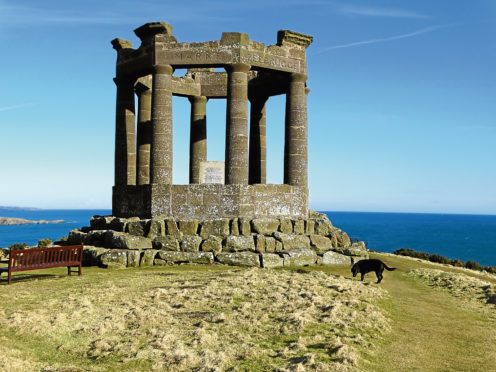On Monday I did something I had been meaning to do not quite for as long as I can remember, but for a long time. I drove to Stonehaven to walk to the memorial to the dead of the First World War and the Second World War, which sits atop the Black Hill overlooking the town.
First, I drove down to the harbour because I can’t resist looking at boats in harbours. Facing you is the clock tower of the Town House of old Stonehaven, built 1790. In 1852 a public barometer was built into a first-floor window, which was of great benefit to the fishing community in the days when they relied on sail power only and weather forecasting depended on unscientific predictions such as “red sky in the morning, shepherd’s warning” weather wisdom.
I remembered the times, more than 60 years ago now, when my father brought the family up to watch the Hogmanay fireballs celebrations. It was an altogether more informal event then and the fireball swingers were mostly local fishermen and their wives.
The war memorial, resembling a ruined classical temple, was completed in 1922 to commemorate more than 200 Stonehaven men and women who died in the First War – around a quarter of those from Scotland who went to war did not return home. Names of the dead from the Second World War were subsequently added.
The Black Hill looks down on to grim and forbidding Dunnottar Castle, sitting impregnably on its outcrop of rock, called plum pudding rock, locally.
With a piercing wind whistling round my ears, I thought of one of the darkest episodes of its history, in May 1685, when 167 Covenanter prisoners – men and women – were incarcerated for their beliefs in a small, low cellar with a single window facing out to sea, known as the Whigs’ Vault. Many died of starvation and disease, some were killed trying to escape and the survivors were transported to the colonies as slaves – truly a Black Hole of Dunnottar.
A more colourful event was the spiriting away of the Honours of Scotland – or Scottish Crown Jewels – which had been lodged in the castle to prevent them falling into the hands of Oliver Cromwell. He had executed King Charles I and declared the Commonwealth with himself as Lord Protector. If he could gain possession of these most potent symbols of Scottish nationhood, he had control of the institutions of monarchy.
The story goes that during an eight-month siege the crown and sceptre and sword of state were secretly lowered down the cliffs to the servant maid of Mrs Granger, wife of the minister of neighbouring Kinneff church, who was pretending to gather dulse (edible seaweed) on the shore.
The maid hid the Honours in a creel, covered them with dulse and carried them off under the noses of the English troops. It must have been a sizeable creel to conceal the Sword of State which is more than four feet long. And she must have been a sturdy lass to carry such a large creel, normally filled with wet dulse, the half dozen miles back to Kinneff manse.
The Honours lay buried in Kinneff Old Church until the Restoration of the monarchy in 1660 when Charles II placed them for safekeeping in Edinburgh Castle. When the Scottish Parliament was dissolved in 1707 they were locked in a chest in the Crown Room where they remained, forgotten, until they were discovered in the most romantic circumstances by Sir Walter Scott in 1818.
Inka had had a good run round a stubble field and hunting through the gorse bushes covering Black Hill. It was time to make for home. I’d pass a few more castles on the way.
There’s little trace now of Adam’s Castle or Whistleberry or Kinneff, which were plundered for their stone for agricultural buildings. At Inverbervie there’s Hallgreen, which I visited in the 1960s when it was in a bad state of disrepair, but it has since been restored and is once again a family home.
Watery grave
The lands of Lauriston Castle, between Johnshaven and St Cyrus, originally extended down to the seashore and harbour of Miltonhaven, reputed to have been a free port, which meant the lairds of Lauriston could land goods there without paying any taxes or excise duty.
A road bridge spans ill-fated Den Fenella, a 70 foot-high waterfall commemorating the death of Fenella, wife of a lord of the Mearns who was complicit, Lady Macbeth-style, in the murder of King Kenneth II in revenge for his part in the murder of her only son.
The dead king’s supporters cornered her at the head of the waterfall and in order to avoid capture and dishonour she “leapt from the rocks to a wild, wild boiling pool where her body was torn and tossed.” I find a measure of healthy scepticism about many of these apocryphal stories adds colour and interest to my days out and about.
And then I was home and ready for a warming bowl of the Doyenne’s homemade soup.


